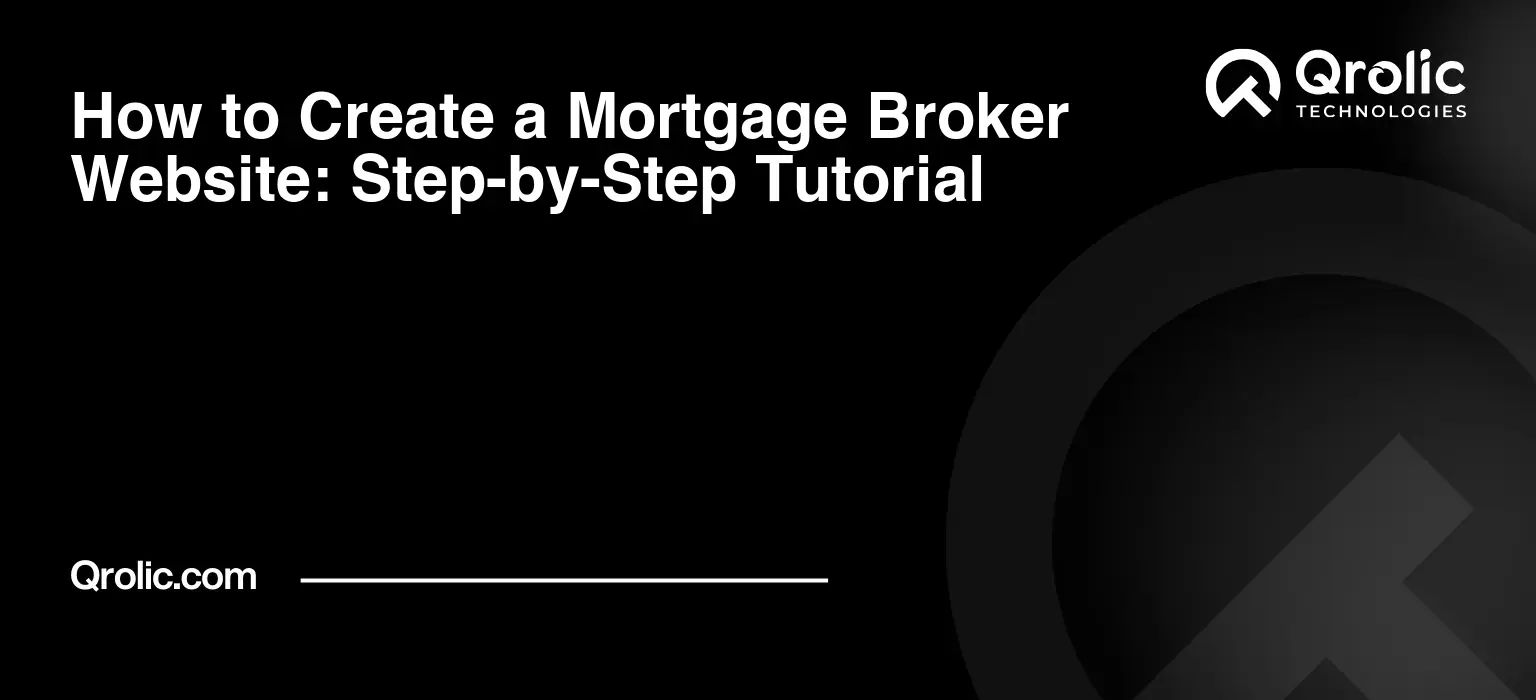Quick Summary:
- A killer website is crucial for your mortgage business.
- Plan, build, optimize, and promote your online presence.
- Focus on clear content, SEO, and great user experience.
Table of Contents
- Why Your Mortgage Brokerage Needs a Killer Website (And Why Now?)
- Step 1: Planning Your Website – The Blueprint for Success
- 1. Define Your Target Audience – Who Are You Trying to Reach?
- 2. Set Clear Goals for Your Website – What Do You Want to Achieve?
- 3. Map Out Your Website Structure & Navigation – The User Journey
- 4. Choose Your Domain Name – Your Online Address
- 5. Gather Essential Content – Words That Sell
- Step 2: Choosing the Right Platform – Your Website’s Foundation
- 1. Website Builders (e.g., Wix, Squarespace, Weebly)
- 2. Content Management Systems (CMS) – WordPress.org (Self-Hosted)
- Step 3: Setting Up WordPress – Laying the Groundwork
- 1. Choose a Web Hosting Provider
- 2. Install an SSL Certificate
- 3. Log In to Your WordPress Dashboard
- Step 4: Choosing a Theme – Your Website’s Visual Identity
- Customizing Your Theme
- Step 5: Installing Essential Plugins – Powering Up Your Website
- Step 6: Creating Your Website Pages – Building the Core
- Step 7: Optimizing Your Website for SEO – Getting Found Online
- Step 8: Promoting Your Website – Driving Traffic and Generating Leads
- Step 9: Monitoring and Maintaining Your Website – Keeping it Fresh and Effective
- Bonus Step: Leveraging Technology Partners for Website Success with Qrolic Technologies
- Conclusion: Your Digital Future Starts Now
Why Your Mortgage Brokerage Needs a Killer Website (And Why Now?)
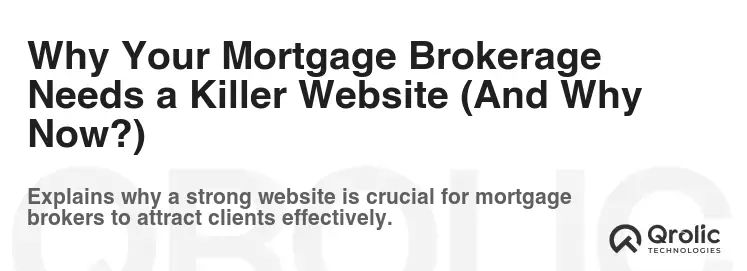
Forget yellow pages and handshake deals. In today’s digital-first world, your mortgage broker website is your 24/7 salesperson, your digital storefront, and often the first impression potential clients have of your business. Without a compelling online presence, you’re practically invisible to a massive pool of qualified borrowers actively searching for their dream home financing.
Here’s the cold, hard truth: Potential clients are online right now, Googling things like “best mortgage rates in [city]” or “mortgage broker near me.” If your website isn’t showing up in those search results, you’re losing business to competitors who are prioritizing their online presence.
More than just visibility, a great website does the following:
- Builds Trust & Credibility: A professional, informative website establishes you as a reputable and reliable mortgage expert. Think of it as your online resume.
- Generates Leads: Your website is a lead generation machine. Capture contact information through forms, offer free resources, and entice visitors to reach out.
- Educates Clients: Simplify the mortgage process. Explain complex concepts in easy-to-understand language, building confidence in your expertise.
- Showcases Your Value: Highlight your unique selling points (USPs), such as specialized loan programs, personalized service, or commitment to client success.
- Saves You Time: Answer frequently asked questions, provide downloadable resources, and streamline the initial consultation process.
- Automates Tasks: Integrate online applications, appointment scheduling, and communication tools to boost efficiency.
- Gives you control over your narrative: control what people see about your business online.
The bottom line? A strong mortgage broker website is no longer optional. It’s a necessity for growth and survival in today’s competitive market.
Step 1: Planning Your Website – The Blueprint for Success
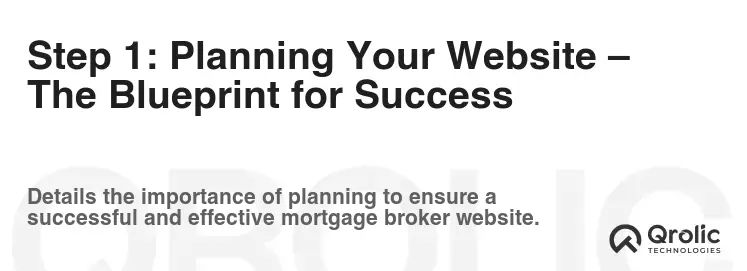
Before you even think about design or code, you need a solid plan. This involves defining your target audience, outlining your website’s goals, and mapping out the user experience. This is your foundational work for a successful finance design that generates revenue.
1. Define Your Target Audience – Who Are You Trying to Reach?
- First-time homebuyers: These individuals need a lot of education and hand-holding. Focus on clear explanations, helpful resources, and a friendly, approachable tone.
- Experienced homeowners (refinancing): These clients are more rate-sensitive and may be looking for specific loan products. Highlight your competitive rates and expertise in refinance options.
- Real estate investors: These clients often have complex financial situations and need a broker who understands their unique needs. Showcase your experience with investment properties and commercial lending.
- High-net-worth individuals: These clients value personalized service and discretion. Focus on premium features, white-glove service, and expertise in jumbo loans.
- Veterans: Highlighting VA loan expertise can tap into a loyal market.
Understanding your ideal client allows you to tailor your messaging, design, and content to resonate with their specific needs and pain points. Think about their age, income level, location, and what they’re searching for online.
2. Set Clear Goals for Your Website – What Do You Want to Achieve?
- Generate leads: Capture contact information from potential clients.
- Book consultations: Encourage visitors to schedule appointments.
- Increase brand awareness: Establish your firm as a trusted mortgage resource.
- Educate clients: Provide valuable information about the mortgage process.
- Improve customer service: Answer FAQs and provide easy access to support.
- Facilitate online applications: Streamline the loan application process.
- Drive traffic to your physical office (if applicable): promote services in your locale to drive business.
Be specific and measurable. For example, instead of “generate leads,” aim for “increase qualified leads by 20% in the next quarter.”
3. Map Out Your Website Structure & Navigation – The User Journey
Imagine yourself as a first-time visitor to your website. Where would you expect to find information? What steps would you take to contact you?
Key pages to include:
- Homepage: Your website’s “front door.” Make a strong first impression with a clear headline, compelling visuals, and a concise overview of your services.
- About Us: Introduce your team, highlight your experience, and build trust. Include photos and testimonials. People buy from people.
- Services: Clearly explain the types of loans you offer (e.g., purchase, refinance, FHA, VA, jumbo).
- Rates: (If applicable and compliant with regulations) Provide current interest rates. Be transparent about how rates are determined.
- Resources: Offer helpful articles, guides, calculators, and checklists related to the mortgage process. This establishes you as an expert.
- Testimonials: Showcase positive feedback from satisfied clients.
- Contact Us: Provide multiple ways for visitors to reach you (phone, email, contact form, live chat).
- Blog: Share your expertise on all things mortgage-related and keep your site fresh and relevant.
- Privacy Policy: Ensure you are transparent with clients data protection practices.
Navigation is key. Use clear, concise labels for your menu items. Ensure visitors can easily find what they’re looking for in just a few clicks. Consider a sitemap to aid both users and search engines.
4. Choose Your Domain Name – Your Online Address
Your domain name is your website’s address on the internet. Choose something that is:
- Relevant: Reflects your business name or the services you offer.
- Memorable: Easy to recall and type.
- Short: Keep it concise to avoid typos.
- Available: Check if the domain name is available with .com, .net, or .org extensions.
Consider using keywords related to your services or location in your domain name (e.g., [city]mortgagebroker.com). However, prioritize brandability and memorability.
5. Gather Essential Content – Words That Sell
Content is king. You’ll need compelling, informative content for each page of your website.
- Homepage copy: Your value proposition, a brief overview of your services, and a clear call to action (e.g., “Get a Free Quote,” “Schedule a Consultation”).
- Service descriptions: Detailed explanations of the types of loans you offer, highlighting the benefits for your clients.
- About Us story: Share your company’s mission, values, and team expertise.
- Testimonials: Collect positive reviews from satisfied clients.
- Blog articles: Write informative articles about topics like first-time homebuyer tips, mortgage refinance options, and current market trends.
Write in clear, concise language that is easy for your target audience to understand. Avoid jargon and technical terms. Focus on the benefits of working with you, not just the features of your services.
Step 2: Choosing the Right Platform – Your Website’s Foundation
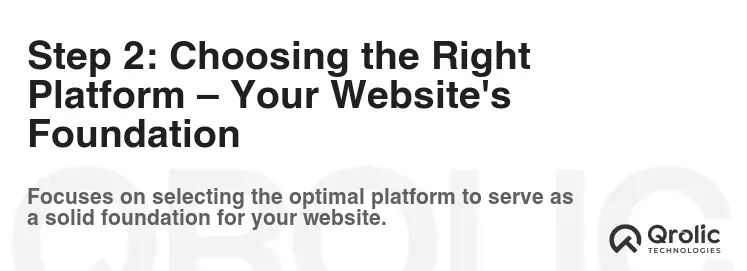
Now that you have a plan, it’s time to choose the platform you’ll use to build your website. There are two main options:
1. Website Builders (e.g., Wix, Squarespace, Weebly)
- Pros: User-friendly, drag-and-drop interfaces, pre-designed templates, no coding required.
- Cons: Limited customization options, can be expensive for advanced features, less control over SEO, can be difficult to migrate to another platform later.
- Best for: Mortgage brokers who need a simple website quickly and easily, with limited technical skills and budget.
2. Content Management Systems (CMS) – WordPress.org (Self-Hosted)
- Pros: Highly customizable, extensive library of themes and plugins, excellent for SEO, more control over your website’s data, scalable for future growth.
- Cons: Requires more technical knowledge, can be more time-consuming to set up and maintain, requires a separate hosting provider.
- Best for: Mortgage brokers who want a professional, scalable website with advanced features and strong SEO performance.
Why WordPress.org is often the best choice for mortgage brokers:
- SEO Powerhouse: WordPress is inherently SEO-friendly and offers a wealth of plugins to optimize your website for search engines.
- Flexibility & Customization: You can customize your website to perfectly match your brand and meet your specific needs.
- Scalability: WordPress can grow with your business. You can easily add new features and functionality as your needs evolve.
- Cost-Effective: While you’ll need to pay for hosting and a theme, WordPress itself is free. The long-term cost can be lower than website builders.
- Control: You own your website and all its data. You’re not locked into a proprietary platform.
This tutorial will focus on building a mortgage broker website using WordPress.org.
Step 3: Setting Up WordPress – Laying the Groundwork
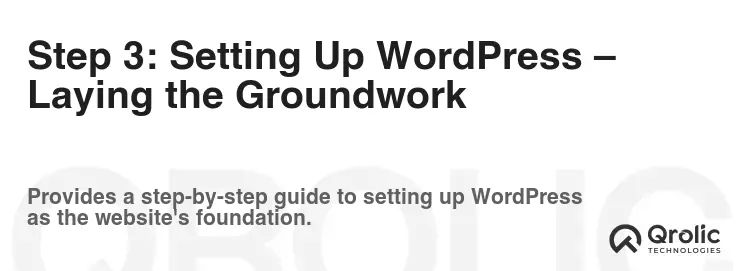
1. Choose a Web Hosting Provider
Your web hosting provider is where your website “lives” on the internet. Choose a reputable provider that offers:
- Reliability: Uptime guarantee (at least 99.9%).
- Speed: Fast loading times.
- Security: SSL certificate, malware scanning, and other security measures.
- Customer Support: Responsive and helpful support team.
- WordPress Compatibility: Easy WordPress installation.
Popular web hosting providers include:
- Bluehost
- SiteGround
- HostGator
- DreamHost
Most hosting providers offer one-click WordPress installation. Follow their instructions to install WordPress on your domain.
2. Install an SSL Certificate
An SSL certificate encrypts the data transmitted between your website and your visitors’ browsers, protecting sensitive information like passwords and credit card details. Most hosting providers offer free SSL certificates through Let’s Encrypt.
3. Log In to Your WordPress Dashboard
Once WordPress is installed, you can access your dashboard by visiting your domain name followed by /wp-admin (e.g., yourdomain.com/wp-admin). Use the username and password you created during the installation process.
Step 4: Choosing a Theme – Your Website’s Visual Identity
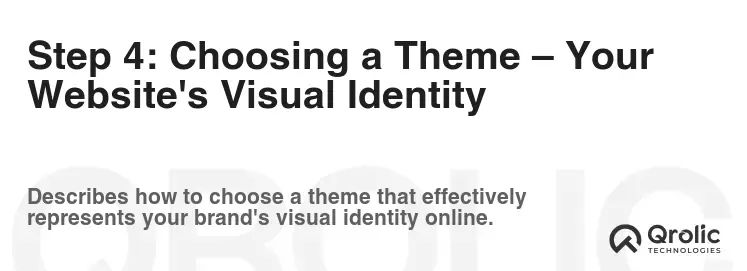
Your WordPress theme controls the overall design and layout of your website. Choose a theme that is:
- Professional: Clean, modern, and visually appealing.
- Responsive: Looks great on all devices (desktops, tablets, and smartphones).
- SEO-Friendly: Optimized for search engines.
- Customizable: Allows you to easily change colors, fonts, and other design elements.
- Fast-Loading: Doesn’t slow down your website.
Where to find WordPress themes:
- WordPress.org Theme Directory: A vast library of free themes.
- ThemeForest: A marketplace for premium WordPress themes.
- Elegant Themes (Divi): A popular theme with a drag-and-drop builder.
Consider these themes specifically designed for financial services or business websites:
- Astra
- OceanWP
- GeneratePress
- Avada
- Divi
How to install a WordPress theme:
- In your WordPress dashboard, go to Appearance > Themes.
- Click “Add New.”
- Search for a theme or upload a theme file (if you purchased a premium theme).
- Click “Install” and then “Activate.”
Customizing Your Theme
Once you’ve installed your theme, you can customize it to match your brand and preferences. Most themes offer customization options through the WordPress Customizer (Appearance > Customize).
- Logo: Upload your company logo.
- Colors: Choose a color scheme that reflects your brand.
- Fonts: Select fonts that are easy to read and visually appealing.
- Homepage layout: Customize the layout of your homepage.
- Menus: Create navigation menus to help visitors find what they’re looking for.
- Widgets: Add widgets to your sidebar and footer to display additional information.
Step 5: Installing Essential Plugins – Powering Up Your Website
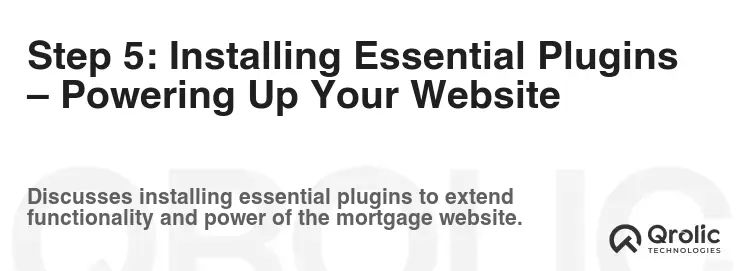
WordPress Plugins add extra features and functionality to your website. Here are some essential plugins for a mortgage broker website:
- Yoast SEO: Optimizes your website for search engines.
- Contact Form 7 or WPForms: Creates contact forms for lead generation.
- Akismet Anti-Spam: Protects your website from spam comments.
- UpdraftPlus: Backs up your website regularly.
- MonsterInsights: Tracks your website’s traffic and analytics.
- Elementor or Beaver Builder: Drag-and-drop page builders for creating custom layouts (if your theme doesn’t offer this).
- Live Chat Plugin (e.g., Tawk.to): Enables real-time communication with website visitors.
- Mortgage Calculator Plugin: Provides an interactive tool for clients to estimate mortgage payments. There are many, so search and compare to find the best one for you.
- Security Plugin (e.g., Wordfence): Enhance your website’s security against attacks.
How to install a WordPress plugin:
- In your WordPress dashboard, go to Plugins > Add New.
- Search for a plugin or upload a plugin file (if you purchased a premium plugin).
- Click “Install Now” and then “Activate.”
Step 6: Creating Your Website Pages – Building the Core
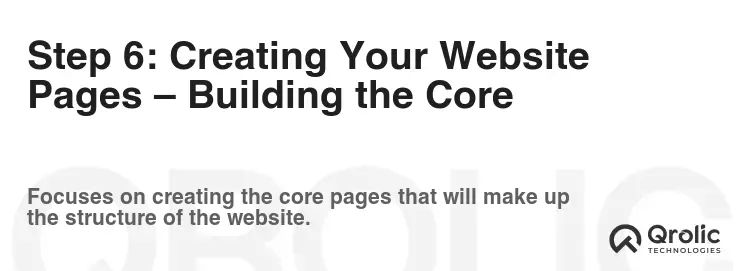
Now it’s time to create the core pages of your website. Go to Pages > Add New to create a new page.
1. Homepage:
- Headline: A clear and compelling headline that summarizes your value proposition. (e.g., “Helping You Find the Right Mortgage Solution”)
- Brief description: A concise overview of your services and what makes you different.
- Call to action: Encourage visitors to take the next step (e.g., “Get a Free Quote,” “Schedule a Consultation”).
- Visuals: Use high-quality images or videos that showcase your brand and services.
2. About Us:
- Company story: Share your company’s mission, values, and history.
- Team bios: Introduce your team members and highlight their experience.
- Credentials: Display your licenses, certifications, and affiliations.
- Testimonials: Include positive reviews from satisfied clients.
3. Services:
- Detailed descriptions: Explain each of the loan products you offer (e.g., purchase, refinance, FHA, VA, jumbo).
- Benefits: Highlight the advantages of each loan product for your clients.
- Eligibility requirements: Provide information about the requirements for each loan product.
- Call to action: Encourage visitors to contact you for more information or to apply for a loan.
4. Rates (Optional):
- Current interest rates: (If applicable and compliant with regulations) Display current interest rates for different loan products.
- Disclaimers: Include disclaimers stating that rates are subject to change and that not all applicants will qualify.
5. Resources:
- Blog articles: Share informative articles about the mortgage process.
- Guides: Offer downloadable guides on topics like first-time homebuying and mortgage refinancing.
- Calculators: Provide interactive calculators for estimating mortgage payments, affordability, and other financial calculations.
- Checklists: Offer checklists for preparing for the mortgage application process.
6. Contact Us:
- Contact form: Use a contact form plugin to create a form for visitors to submit inquiries.
- Phone number: Display your phone number prominently.
- Email address: Provide your email address.
- Address: (If applicable) Display your physical address.
- Map: Embed a Google Map showing your location.
Step 7: Optimizing Your Website for SEO – Getting Found Online
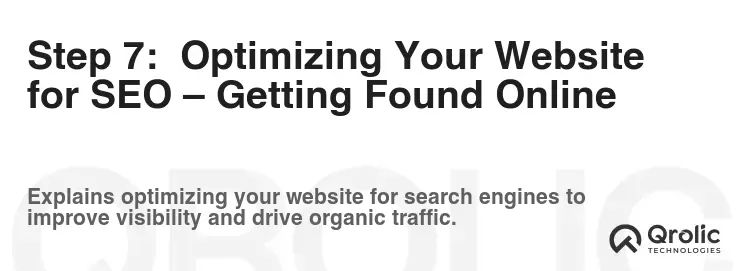
SEO (Search Engine Optimization) is the process of optimizing your website to rank higher in search engine results pages (SERPs). This is crucial for attracting organic traffic to your website. You want people to easily find you when searching “mortgage broker website”.
Key SEO strategies for mortgage brokers:
- Keyword research: Identify the keywords that your target audience is using to search for mortgage services online. Use tools like Google Keyword Planner, SEMrush, or Ahrefs. Keywords: mortgage broker website, step-by-step guide, finance design.
- On-page optimization: Optimize your website’s content and structure for your target keywords. This includes:
- Title tags: Use relevant keywords in your page titles.
- Meta descriptions: Write compelling meta descriptions that entice users to click on your website in the search results.
- Header tags (H1, H2, H3): Use header tags to structure your content and highlight important keywords.
- Content: Create high-quality, informative content that is relevant to your target keywords.
- Image alt tags: Add descriptive alt tags to your images.
- Internal linking: Link to other relevant pages on your website.
- URL structure: Use short, descriptive URLs that include your target keywords.
- Off-page optimization: Build backlinks to your website from other reputable websites. This helps to improve your website’s authority and credibility.
- Directory listings: List your business in online directories like Yelp, Google My Business, and Bing Places for Business.
- Guest blogging: Write guest posts for other websites in your industry.
- Social media: Share your content on social media.
- Local SEO: Optimize your website for local search. This is especially important for mortgage brokers who serve a specific geographic area.
- Google My Business: Create and optimize your Google My Business listing.
- NAP consistency: Ensure that your name, address, and phone number (NAP) are consistent across all online platforms.
- Local citations: Get listed in local directories and online business listings.
- Mobile-friendliness: Ensure your site is responsive and easily accessible on mobile devices. Google prioritizes mobile-friendly sites.
- Website Speed: Optimize your website for speed. Use tools like Google PageSpeed Insights to identify areas for improvement.
Yoast SEO Plugin: Install and configure the Yoast SEO plugin to help you optimize your website for search engines. It provides valuable guidance on keyword usage, readability, and other SEO best practices.
Step 8: Promoting Your Website – Driving Traffic and Generating Leads
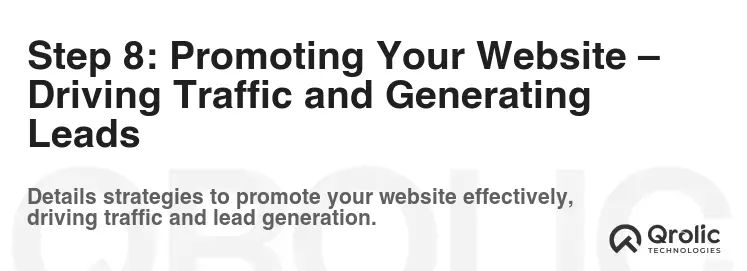
Building a great website is only half the battle. You also need to promote it to drive traffic and generate leads.
Effective website promotion strategies for mortgage brokers:
- Search engine marketing (SEM): Run paid advertising campaigns on search engines like Google and Bing.
- Social media marketing: Share your content on social media platforms like Facebook, LinkedIn, and Twitter.
- Email marketing: Build an email list and send out newsletters and promotional emails.
- Content marketing: Create valuable content that attracts and engages your target audience.
- Local partnerships: Partner with real estate agents, builders, and other local businesses to promote your services.
- Networking: Attend industry events and networking meetings.
- Referral program: Encourage satisfied clients to refer new business to you.
- Online directories: List your website in online directories.
- Offline marketing: Include your website address on your business cards, brochures, and other marketing materials.
Step 9: Monitoring and Maintaining Your Website – Keeping it Fresh and Effective
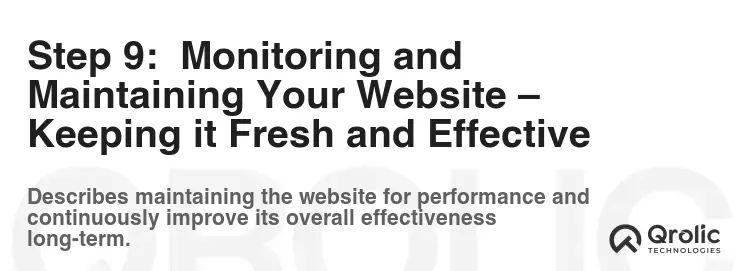
Your website is not a “set it and forget it” project. You need to monitor its performance and make regular updates to keep it fresh and effective.
Key tasks for website maintenance:
- Track your website’s traffic and analytics: Use Google Analytics to monitor your website’s traffic, bounce rate, conversion rate, and other key metrics.
- Update your website’s content: Keep your content fresh and relevant by adding new articles, blog posts, and resources.
- Update your website’s software: Keep your WordPress core, themes, and plugins up to date to ensure security and compatibility.
- Back up your website regularly: Back up your website regularly to protect your data in case of a disaster.
- Test your website’s functionality: Regularly test your website’s forms, links, and other functionality to ensure that everything is working properly.
- Monitor your website’s security: Monitor your website for security vulnerabilities and take steps to protect it from hackers.
- Gather feedback from your clients: Ask your clients for feedback on your website and use their suggestions to improve it.
Bonus Step: Leveraging Technology Partners for Website Success with Qrolic Technologies
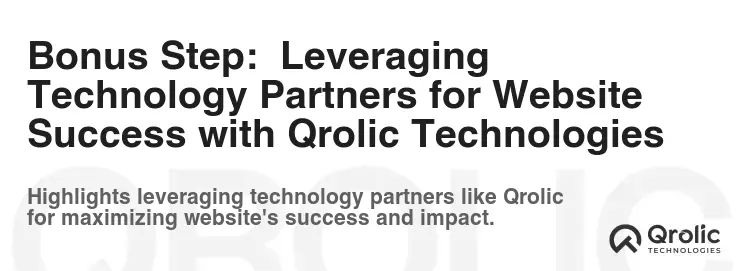
Creating and managing a high-performing mortgage broker website can be demanding. That’s where partnering with technology experts like Qrolic Technologies can provide significant benefits.
How Qrolic Technologies Can Help:
- Custom Website Development: Qrolic Technologies can build a fully customized mortgage broker website tailored to your specific needs and branding, ensuring a unique and professional online presence.
- Advanced SEO Strategies: Benefit from expert SEO services that go beyond basic optimization. Qrolic can implement advanced strategies to improve your search engine rankings and drive organic traffic.
- Lead Generation Solutions: Implement effective lead generation strategies, including optimized landing pages, targeted content, and conversion-focused design.
- Website Security and Maintenance: Ensure your website is secure, reliable, and up-to-date with ongoing maintenance and security monitoring.
- Integrations with Loan Origination Systems (LOS): Streamline your processes by integrating your website with your LOS, enabling seamless data transfer and improved efficiency.
- Mobile-First Design: Ensure your website is fully responsive and provides an excellent user experience on all devices, catering to the growing number of mobile users.
- Content Creation and Management: Get help with creating high-quality, engaging content that attracts and educates your target audience, establishing you as a trusted authority in the mortgage industry.
- Performance Monitoring and Optimization: Continuously monitor your website’s performance and optimize it for speed, usability, and conversion, ensuring you get the most out of your online presence.
- Custom Software Solutions: if you have bespoke requirments, qrolic can provide bespoke software for your Mortgage broker business.
By partnering with Qrolic Technologies, you can focus on your core business – helping clients secure their dream homes – while leaving the technical aspects of your website in capable hands. Contact Qrolic Technologies to explore how they can help you build a powerful and effective mortgage broker website.
Conclusion: Your Digital Future Starts Now

Creating a successful mortgage broker website is an ongoing process. By following these steps, you can build a website that attracts new clients, establishes your credibility, and helps you grow your business. Remember to focus on providing value to your visitors, optimizing your website for search engines, and continuously monitoring its performance. With dedication and effort, your website can become a powerful tool for success in the competitive mortgage industry.
